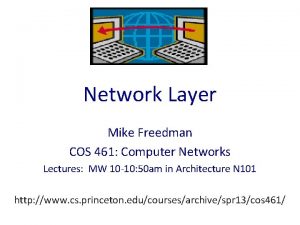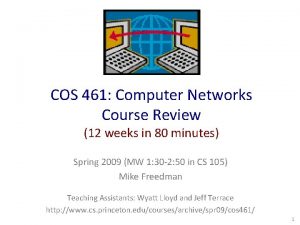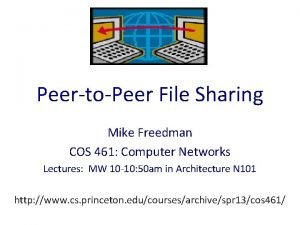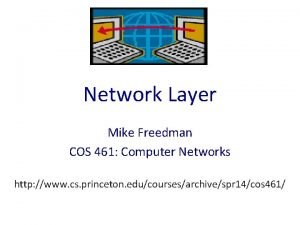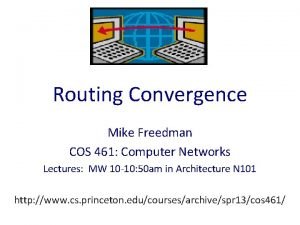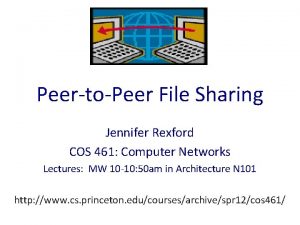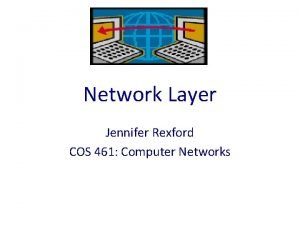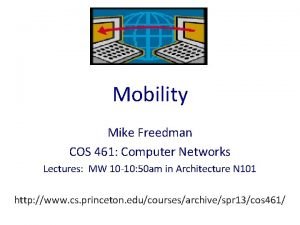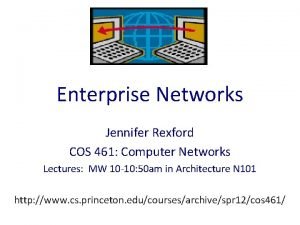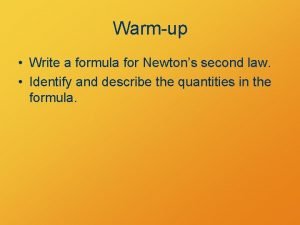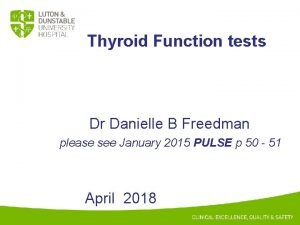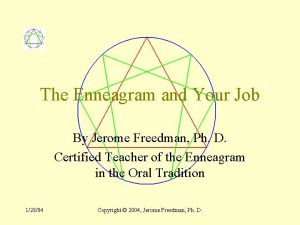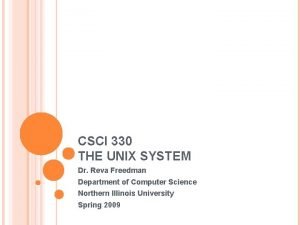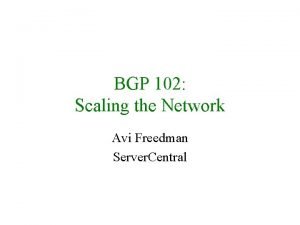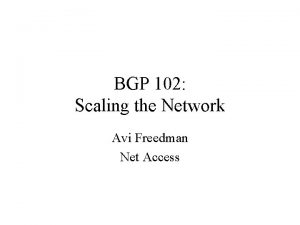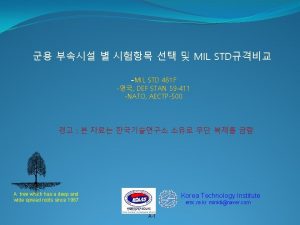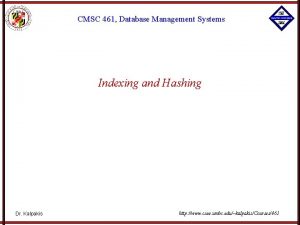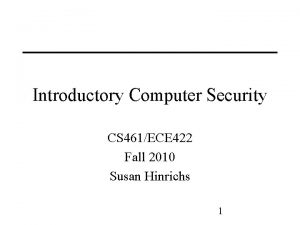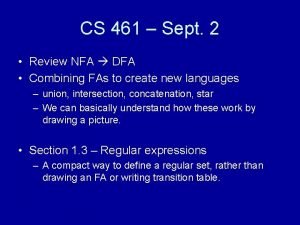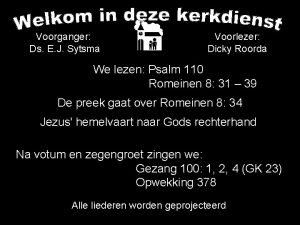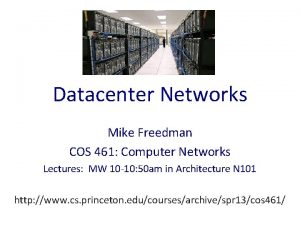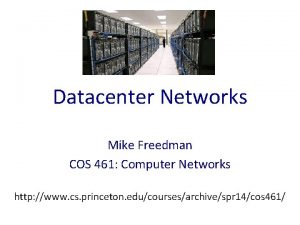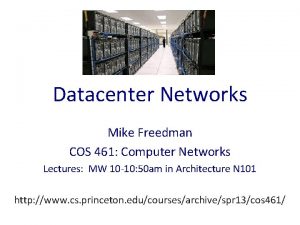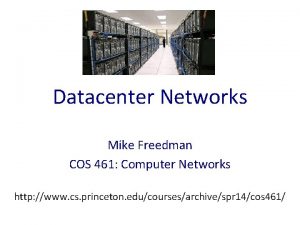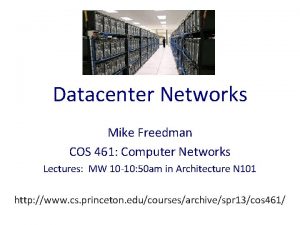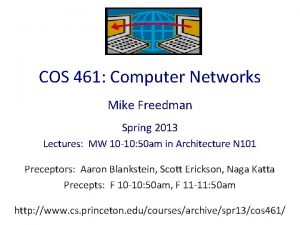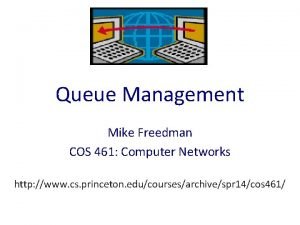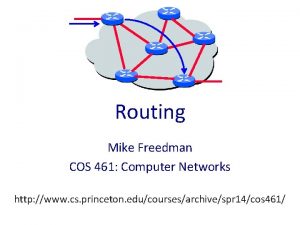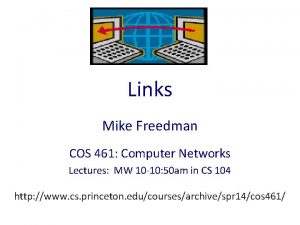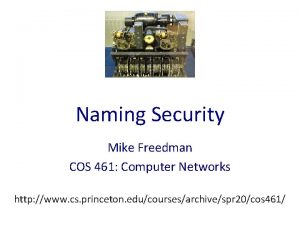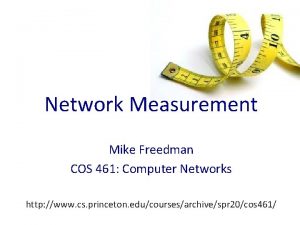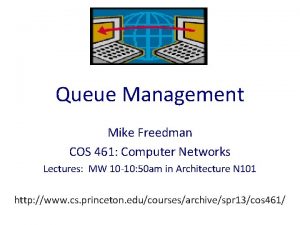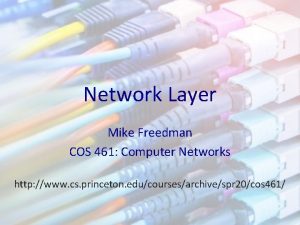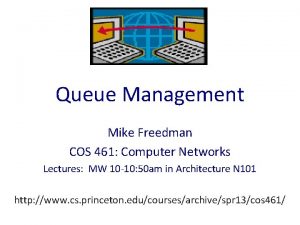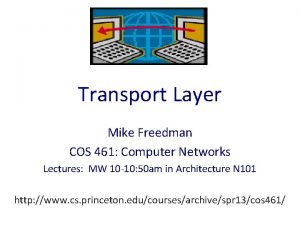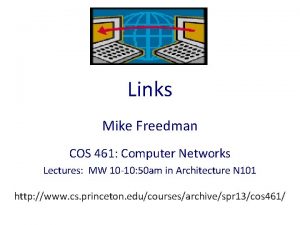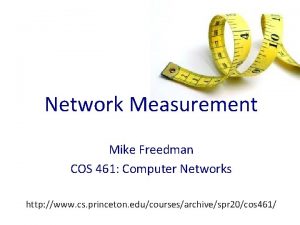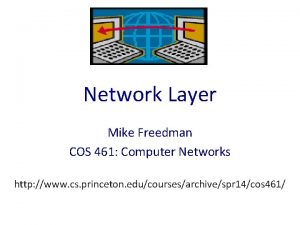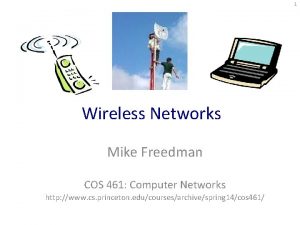COS 461 Computer Networks Mike Freedman Spring 2020
































- Slides: 32

COS 461: Computer Networks Mike Freedman Spring 2020 Lectures: MW 1: 30 -2: 50 pm in Richardson 002 http: //www. cs. princeton. edu/courses/archive/spring 20/cos 461/

Protocol Layers host HTTP message HTTP router Ethernet interface HTTP TCP segment TCP IP host IP packet Ethernet interface Ethernet frame IP TCP router IP packet SONET interface SONET frame IP IP packet Ethernet interface IP Ethernet interface Ethernet frame 2

Link = Medium + Adapters 3

What is a Link? Communication Medium Network Adapter 4

Broadcast Links: Shared Media 5

Adaptors Communicating packet sending node packet link layer protocol frame adapter • Sending side – Encapsulates packet in a frame – Adds error checking bits, flow control, etc. receiving node • Receiving side – Looks for errors, flow control, etc. – Extracts datagram and passes to receiving node 6

Link-Layer Services • Encoding – Represent the 0 s and 1 s • Framing – Encapsulate packet into frame, adding header/trailer • Error detection – Receiver detecting errors with checksums • Error correction – Receiver optionally correcting errors • Flow control 7

Addresses 8

Medium Access Control Address • Identify the sending and receiving adapter – Unique identifier for each network adapter – Identifies the intended receiver(s) of the frame – … and the sender who sent the frame 9

Medium Access Control Address • MAC address (e. g. , 00 -15 -C 5 -49 -04 -A 9) – Numerical address used within a link – Unique, hard-coded in the adapter when it is built – Flat name space of 48 bits • Hierarchical allocation: Global uniqueness! – Blocks: assigned to vendors (e. g. , Dell) by the IEEE – Adapters: assigned by the vendor from its block • Broadcast address (i. e. , FF-FF-FF-FF) – Send the frame to all adapters 10

As an Aside: Promiscuous Mode • Normal adapter: receives frames sent to – The local MAC address – Broadcast address FF-FF-FF-FF • Promiscuous mode – Receive everything, independent of destination MAC • Useful for packet sniffing – Network monitoring – E. g. , wireshark, tcpdump 11

Why Not Just Use IP Addresses? • Links can support any network protocol – Not just for IP (e. g. , IPX, Appletalk, X. 25, …) – Different addresses on different kinds of links • An adapter may move to a new location – So, cannot simply assign a static IP address – Instead, must reconfigure the adapter’s IP address • Must identify the adapter during bootstrap – Need to talk to the adapter to assign it an IP address 12

Who Am I: Acquiring an IP Address 71 -65 -F 7 -2 B-08 -53 1 A-2 F-BB-76 -09 -AD DHCP server ? ? 0 C-C 4 -11 -6 F-E 3 -98 1. 2. 3. 6 • Dynamic Host Configuration Protocol (DHCP) – Broadcast “I need an IP address, please!” – Response “You can have IP address 1. 2. 3. 4. ” 13

Who Are You: Discovering the Receiver 71 -65 -F 7 -2 B-08 -53 1 A-2 F-BB-76 -09 -AD 1. 2. 3. 4 1. 2. 3. 5 0 C-C 4 -11 -6 F-E 3 -98 1. 2. 3. 6 • Address Resolution Protocol (ARP) – Broadcast “who has IP address 1. 2. 3. 6? ” – Response “ 0 C-C 4 -11 -6 F-E 3 -98 has 1. 2. 3. 6!” 14

Sharing the Medium 15

Collisions 71 -65 -F 7 -2 B-08 -53 1 A-2 F-BB-76 -09 -AD 0 C-C 4 -11 -6 F-E 3 -98 • Single shared broadcast channel – Avoid having multiple nodes speaking at once – Otherwise, collisions lead to garbled data 16

Multi-Access Protocol • Divide the channel into pieces – in frequency vs. in time 17

Multi-Access Protocol • Take turns – Do not transmit w/o token – With token, transmit for up to some max time/length – Pass token to right • Punt – Let collisions happen – … and detect and recover from them 18

Like Human Conversation… • Carrier sense – Listen before speaking – …and don’t interrupt! • Collision detection – Detect simultaneous talking – … and shut up! • Random access – Wait for a random period of time – … before trying to talk again! 19

Carrier Sense Multiple Access • Listen for other senders – Then transmit your data • Collisions can still occur – Propagation delay – Wasted transmission 20

CSMA/CD Collision Detection • Detect collision – Abort transmission – Jam the link • Wait random time – Transmit again • Hard in wireless – Must receive data while transmitting 21

Comparing the Three Approaches • Channel partitioning is (a) Efficient/fair at high load, inefficient at low load (b) Inefficient at high load, efficient/fair at low load • “Taking turns” (a) Inefficient at high load (b) Efficient at all loads (c) Robust to failures • Random access (a) Inefficient at low load (b) Efficient at all load (c) Robust to failures 22

Ethernet 24

Ethernet • Dominant wired LAN technology • First widely used LAN technology • Kept up with speed race: 10 Mbps – 40 Gbps Metcalfe’s Ethernet sketch 25

Ethernet Uses CSMA/CD • Carrier Sense: wait for link to be idle – Channel idle: start transmitting – Channel busy: wait until idle • Collision Detection: listen while transmitting – No collision: transmission is complete – Collision: abort transmission, and send jam signal • Random Access: exponential back-off – After collision, wait random time before trying again – After mth collision, choose K randomly from {0, …, 2 m-1} – … and wait for K*512 bit times before trying again 26

Limitations on Ethernet Length A B latency d • Latency depends on physical length of link – Time to propagate a packet from one end to other • Suppose A sends a packet at time t – And B sees an idle line at a time just before t+d – … so B happily starts transmitting a packet • B detects a collision, and sends jamming signal – But A doesn’t see collision till t+2 d 27

Limitations on Ethernet Length A B latency d • A needs to wait for time 2 d to detect collision – So, A should keep transmitting during this period – … and keep an eye out for a possible collision • Imposes restrictions on Ethernet – Maximum length of the wire: 2500 meters – Minimum length of the packet: 512 bits (64 bytes) 28

Ethernet Frame Structure • Sending adapter encapsulates packet in frame • Preamble: synchronization – Seven bytes with pattern 1010, followed by one byte with pattern 10101011 – Used to synchronize receiver, sender clock rates 29

Ethernet Frame Structure • Addresses: source and destination MAC addresses – Adaptor passes frame to network-level protocol • If destination is local MAC address or broadcast address – Otherwise, adapter discards frame • Type: indicates the higher layer protocol – Usually IP – But also Novell IPX, Apple. Talk, … • CRC: cyclic redundancy check – Checked at receiver – If error is detected, the frame is simply dropped 30

Unreliable, Connectionless Service • Connectionless – No handshaking between send and receive adapter • Unreliable – Receiving adapter doesn’t send ACKs or NACKs – Packets passed to network layer can have gaps – Gaps can be filled by transport protocol (e. g. , TCP) – Otherwise, the application will see the gaps 31

Summary: Multiple Layers • Different devices switch different things – Network layer: packets (routers) – Link layer: frames (bridges and switches) – Physical layer: electrical signals (repeaters and hubs) Application Transport Router Frame Packet TCP header User data Bridge, switch Repeater, hub 32

Conclusion • Links – Connect two or more network adapters – … each with a unique address – … over a shared communication medium • Coming next – Network layer (IP) 33
 Cos 461
Cos 461 Cos 461
Cos 461 Cos 461
Cos 461 Cos 461
Cos 461 Cos 461
Cos 461 Cos 461
Cos 461 Cos 461
Cos 461 Cos 461
Cos 461 Cos 461
Cos 461 Cos 461
Cos 461 Puwifi
Puwifi Virtual circuit network
Virtual circuit network Backbone networks in computer networks
Backbone networks in computer networks Young and freedman
Young and freedman Current resistance and electromotive force
Current resistance and electromotive force Capacitncia
Capacitncia Danielle freedman
Danielle freedman Rabbi david freedman
Rabbi david freedman Neil freedman
Neil freedman Steve freedman
Steve freedman Jerome freedman
Jerome freedman Csci 330
Csci 330 Avi freedman net worth
Avi freedman net worth Avi freedman net worth
Avi freedman net worth Spring, summer, fall, winter... and spring cast
Spring, summer, fall, winter... and spring cast Summer autumn winter spring
Summer autumn winter spring Mil-std-461g re102
Mil-std-461g re102 Cmsc 461
Cmsc 461 Uiuc cs 461
Uiuc cs 461 Cs 461
Cs 461 Ccna voice 640-461 pdf
Ccna voice 640-461 pdf Kkk 461
Kkk 461 Opwekking 461 tekst
Opwekking 461 tekst

